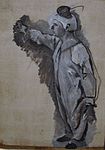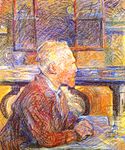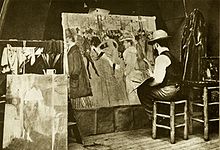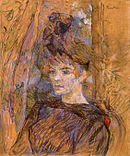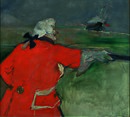Henri de Toulouse-Lautrec
Henri Marie Raymond de Toulouse-Lautrec-Monfa (born November 24, 1864 in Albi , † September 9, 1901 at Malromé Castle, Gironde ) was a French painter and graphic artist of post-impressionism in the late 19th century. He was particularly famous for his posters, which he designed for the Parisian variety theater Moulin Rouge on Montmartre , among others .
Life
Origin and childhood
Henri de Toulouse-Lautrec came from an old noble family. The later Counts de Toulouse-Lautrec come from the male line of the de Lautrec family . This can be traced back to an Aton missus comitis et vicarius in the year en 898. Sicard VI., Vicomte de Lautrec († 1158), was, according to new research, probably a son of Frotard III., Seigneur et vicomte de Lautrec . Alexandre de Lautrec (1633–1699), Seigneur de Geynes, younger son of Bernard de Lautrec, Seigneur de Monfa, however, took the name de Toulouse-Lautrec because he claimed that Sicard VI. de Lautrec was a son of Baldwin of Toulouse (1165-1214) from the line Saint-Gilles of the Counts of Toulouse and his wife Alix de Lautrec. The Counts of Toulouse can be traced back to the time of Charlemagne , who left the area around Toulouse to them for administration and defense, and gained a certain importance in the High Middle Ages through an exposed role in the Crusades , but died out in the Middle Ages.
In the 19th century, the members of the Toulouse-Lautrec family lived in material prosperity on estates in southern France. In order to counteract a reduction in family ownership through the division of inheritance, one often married within the relatives. These relatives marriages and the resulting impoverishment of the gene pool is also the reason for the occurrence of Henri de Toulouse-Lautrec's hereditary disease .
The marriage that Henri's parents, Count Alphonse de Toulouse-Lautrec-Monfa (1838-1913), and his first cousin, Countess Adèle Tapié de Céleyran (1841-1930), entered into on May 9, 1863, was one such relatives marriage; the mothers of both spouses were sisters. The following year, on November 24, 1864, Countess Adèle gave birth to her first child, Henri, in the Hôtel du Bosc in Albi . The second son, Richard, born in 1867, died after just one year. The marriage of convenience between Henri's parents turned out to be short-lived due to the different characters, so that the couple went their separate ways after Richard's death, although they remained married. Henri was raised by his mother, who after the loss of her second child and the broken marriage saw the meaning of her life in the Catholic faith and in the care for her remaining son. He spent his first years with cousins in the castles of Céleyran and Le Bosc. Henri was pampered and sometimes had an imperious demeanor; but he is also portrayed as a happy and engaging child. In the evening they took away his crayons because he was supposed to go to sleep. He would then sneak to the stove, grab a piece of charcoal, and continue painting.
Henri gave the first lessons to a distant relative. At the age of eight he came to the Lycée Fontanes (now Lycée Condorcet ) in Paris for two years , where the family had moved in 1872. They rented a floor in the Hotel Pérey. Due to his weak health, however, he had to leave school again in 1875 and received private lessons in various spas.
Henri suffered from pycnodysostosis , an autosomal recessive hereditary disease that manifests itself as short stature. Her main symptoms appeared around the age of ten. In two accidents, Henri broke both legs one after the other as a 13- and 14-year-old. Due to illness, as an adult he was only 1.52 meters tall.

During the lengthy reclining cures and sanatorium stays associated with his illness , his artistic talent became more and more evident. In his drawings, the youngster mainly depicted people and animals, and sketches that have survived to this day prove that he was not a child prodigy, but was definitely gifted. A friend of his father's, the deaf animal painter René Princeteau , introduced him to the basics of painting during several stays in Paris.
In his first oil paintings, which he painted at the age of 14, he depicted motifs from the manorial milieu of his parents' house, including hunting and, again and again, horses - with carriages, riders and dogs. This was due on the one hand to the specialization of his teacher, on the other hand the young Henri tried to impress his father with these motifs, who was a passionate rider and hunter.
With great difficulty, Henri passed the first part of the Abitur in Toulouse on the second attempt in November 1881 . The second exam did not take place, because at this point it was already clear to him that he wanted to become a painter. There was no resistance from parents to this career aspiration in the Toulouse-Lautrec household; his father discussed with befriended painters who recommended an academic study of painting for the son. In 1883 the mother bought her main residence, the Château Malromé near Bordeaux .
Academic years
Henri Toulouse-Lautrec entered the studio of the Parisian fashion painter Léon Bonnat on April 17, 1882 . A few weeks later the young art student reported how his teacher judged his work: "He said to me: 'Your painting is not bad at all, [...] but your drawing is utterly abhorrent!'" École des Beaux-Arts Berufene did not take his pupil into the class there.
Toulouse-Lautrec finally found in Fernand Cormon , a Parisian salon painter who is insignificant from today's perspective , a more liberal academic teacher who particularly liked his drawings. Lautrec, who visited this studio until 1886, did not feel encouraged by its praise: “Cormon's corrections are much more benevolent than those of Bonnat. […] You will be surprised, but I actually don't like that much. The lashes of my former patron were sharp and I did not spare myself. Here I am weakened and need courage to make a careful drawing, when Cormon's eyes would also do a worse one. "
Although he submitted to the rules and customs of academic teaching, Toulouse-Lautrec developed his own technique and a painterly free conception from the start that contrasted with the art of the Paris salon that was predominant at the time . In addition to taking drawing lessons from Bonnat and then from Cormon, he visited the exhibitions of Edgar Degas , Pierre-Auguste Renoir and Édouard Manet in Paris .
For Toulouse-Lautrec during this time, more drastic than Cormon's instructions were the new surroundings and the friends he made among the students, including Louis Anquetin , Émile Bernard and Vincent van Gogh . His painting by Bernard was created in 1885, followed by a pastel painting by Van Gogh two years later . It shows van Gogh with the regular absinthe glass .
Portrait of Émile Bernard , 1885, National Gallery (London)
Portrait of the mother , around 1886, Musée Toulouse-Lautrec , Albi
Clown , around 1886/87, Alte Nationalgalerie (Berlin)
Portrait Vincent van Gogh , 1887, Van Gogh Museum , Amsterdam
Life as bohemians
While the young painter initially felt harassed by the new impressions, the area of life of his friends around Montmartre increasingly gained the upper hand over the family refuge at the Cité du Rétiro. In the summer of 1884, the 20-year-old finally moved in with his friends Lilly and René Grenier, a fellow student of Bonnat and Cormon, in the rear building at 19 Rue Fontaine, very close to Place Blanche , where the famous Reine Blanche dance hall a few years later had to give way to the new Moulin Rouge . In the house of the wealthy Greniers there were often occasions to celebrate or to go to the entertainment venues with friends, many of which were opening in the neighborhood at this time. The area between Place Blanche, Moulin Rouge and Place Pigalle became his second home. The following January he rented his own studio on Rue Lepic.
At the end of 1887, the Belgian artist group Les Vingt approached Toulouse-Lautrec with the suggestion that they take part in their exhibition at the beginning of the year. He accepted the proposal and exhibited there annually. The first participation in the Salon des Indépendants followed in 1889 . In 1888, Toulouse-Lautrec began to select motifs for which he is known to this day: people from the circus, from entertainment venues and situations from the demi- world environment . The almost forgotten lithography experienced a renaissance through his painting . He found inspiration in Edgar Degas and Paul Gauguin as well as the Japanese woodcut , which had a strong influence on the Impressionists.
In the cafes and restaurants of Montmartre, Henri de Toulouse-Lautrec also had his first exhibitions and he received his first commissions. For artists and personalities of the French Belle Époque , most of whom he knew personally, he made lithographs for posters or as illustrations for newspapers and magazines. One of these personalities was Aristide Bruant , who opened the Cabaret Le Mirliton ( reed flute ) in 1885 . He thus imitated the bar Le Chat Noir opened by Rodolphe Salis in 1881, where “tout Paris” soon met, who wanted to experience a touch of bohemianism with the readings and chansons presented here . For the chansonnier Bruant, Toulouse-Lautrec designed four posters in the 1890s, on which Bruant stands out above all for his trademark, a red scarf.
He had a love affair with his model, who later became painter Suzanne Valadon . He had met her in 1887 - she lived on the first floor of the house at 7 rue Tourlaque, where his studio was. This relationship ended abruptly after two years with her attempted suicide, possibly with the aim of convincing him to marry.
A chanson star equal to Bruant was Yvette Guilbert , who Toulouse-Lautrec met in 1893 through the writer Maurice Donnay , who wrote texts for her. In addition to many sketches, he created two albums of her lithographs. After some hesitation, Guilbert recognized his realistic but caricaturing style.
Yvette Guilbert greets the audience , gouache on cardboard, 1894
Illness and early death

Toulouse-Lautrec turned to alcohol , which led to delirium tremens for the first time in 1898 . In 1899 his mother sent him to the Neuilly sanatorium for three months of rehab. After his release, he stayed in various places, including Le Havre , Arcachon and Bordeaux. In April 1901 he returned to Paris, completed, arranged and signed his works. He left Paris on July 15th and moved to Taussat, where he suffered an attack of paralysis. His mother took him to Malromé on August 20, where he painted his last picture, Admiral Viaud .
Henri Toulouse-Lautrec died at the age of only 36 on September 9, 1901 in the presence of his parents in his parents' castle Malromé. He was buried in Saint-André-du-Bois and later reburied in Verdelais ( Gironde ).
plant
Subject
With his unvarnished scenes of the Parisian nightlife around Montmartre, Lautrec reflected the image of a legendary time, the so-called Belle Époque . Toulouse-Lautrec was primarily a portraitist: the individual, not the crowd, was his subject.
Above all, however, he played a leading role in the development of poster art with the help of color lithography , which is now regarded as a milestone in advertising. Lautrec used a few colored stones in yellow, red and blue on large-format sheets, which also had an attractive effect from a distance due to their strong contrasts. The use of the lithographic technique in the early 1890s not only marked the breakthrough for the artist, the 351 works created in this way are also what made him famous to this day.
Pictures (selection)
Lautrec's oeuvre is very extensive: it consists of 737 oil paintings , 275 watercolors , 5084 drawings and 359 lithographs (53 multicolored and 306 monochrome).
- 1894: The salon on Rue des Moulins, Musée Toulouse-Lautrec.
- 1898: Bar, Kunsthaus Zurich .
Commemoration
Toulouse-Lautrec's Life was filmed in 1952 by director John Huston . The film is titled Moulin Rouge , based on the novel of the same name by Pierre La Mure , which is based on Toulouse-Lautrec's life story and was published in 1950. Another film Lautrec - The Painter of Montmartre was produced in 1998, directed by Roger Planchon. He is heavily oversubscribed in Baz Luhrmann's film musical Moulin Rouge from 2001, played by John Leguizamo , as well as in Christopher Moore's novel Verflixtes Blau . Toulouse-Lautrec is also the first key figure of the Belle Epoque that Gil Pender ( Owen Wilson ) meets in the film Midnight in Paris (2011). The Musée Toulouse-Lautrec has existed since 1922 and is mainly dedicated to his life and work.
On May 23, 2000 the asteroid (11506) Toulouse-Lautrec was named after him.
Exhibitions
- In 1964, his works were shown at the documenta III in Kassel in the famous hand drawings department .
- From August 2014 to January 2015, the Emil Schumacher Museum in Hagen hosted the extensive exhibition "Henri de Toulouse-Lautrec - The Master of the Line" for the artist's 150th birthday. The extensive retrospective from the Gerstenberg collection provided an overview of the painter's prints. In addition to the famous portfolios such as "Elles" or "Suite Française" for the singer Yvette Guilbert , the famous Toulouse-Lautrec posters - for example for the Moulin Rouge or the dancer Jane Avril and the singer Aristide Bruant - could be seen in full.
- From October 2014 to January 2015, the Kunstforum Wien presented the first extensive retrospective on the work in Austria under the title “The Path to Modernism”. The artist's 150th birthday also gave rise to this exhibition.
Collections
Gerstenberg Collection
Before the First World War, Otto Gerstenberg from Berlin combined Lautrec's entire graphic oeuvre. This included lithographs, dedication copies, preferential prints , condition prints and proofs . There were also some paintings by the artist. The collection, which is still in private hands today, includes a large part of Toulouse-Lautrec's graphics.
Toulouse-Lautrec Museum
Toulouse-Lautrec left most of his pictures to his family and mother. At her instigation the Musée Toulouse-Lautrec was opened in Albi in 1922 .
Literature and New Media
Secondary literature
- Götz Adriani : Toulouse-Lautrec. Paintings and picture studies. DuMont, Cologne 2002, ISBN 3-8321-7163-0 .
- Matthias Arnold: Toulouse-Lautrec. 1864-1901. The theater of life. Taschen, Cologne 1987, ISBN 3-8228-0046-5 (6th edition, ibid 2007, ISBN 978-3-8228-0046-1 ).
- Matthias Arnold: Henri de Toulouse-Lautrec. With testimonials and photo documents. 8th edition. Rowohlt, Reinbek bei Hamburg 2002, ISBN 3-499-50306-9 .
- Gilles Néret: Henri de Toulouse-Lautrec. Taschen, Cologne 2009, ISBN 978-3-8365-1087-5 .
- Henri Perruchot : Toulouse-Lautrec. A biography. Bechtle, Esslingen 1958 (French original under the title La vie de T.-L. , Hachette, Paris 1958).
- Fritz Nemitz: Henri Toulouse - Lautrec Montmartre 45 lithographs. Munich 1955.
Movie
- Moulin Rouge , 1952. Director: John Huston (TL. Portrayed by José Ferrer )
- Toulouse-Lautrec , 1998. Directed by Roger Planchon
- Lautrec, 1999. Musical, directed by Charles Aznavour
- Moulin Rouge , 2001. Film musical, directed by Baz Luhrmann
- Hilary Chadwick : Toulouse-Lautrec. Documentation, DVD, Arthaus Musik, Halle (Saale) 2009, ISBN 978-3-941311-81-7
- Midnight in Paris , 2011. Director: Woody Allen (TL. Portrayed by Vincent Menjou Cortes )
Web links
- Literature by and about Henri de Toulouse-Lautrec in the catalog of the German National Library
- Works by and about Henri de Toulouse-Lautrec in the German Digital Library
- Works by Henri de Toulouse-Lautrec at Zeno.org .
- Materials by and about Henri de Toulouse-Lautrec in the documenta archive
Individual evidence
- ^ Matthias Arnold: Toulouse-Lautrec. Pp. 8-19.
- ^ Matthias Arnold: Toulouse-Lautrec , pp. 20-22.
- ^ Matthias Arnold: Toulouse-Lautrec , p. 26 f.
- ↑ Diana Nitsche: Absinthe - History of a culture and pleasure drug. Dissertation Institute History and Ethics of Medicine, University of Heidelberg, Supervisor Wolfgang U. Eckart , 2005, on the presentation of Vincent van Gogh pp. 96-109.
- ^ Matthias Arnold: Toulouse-Lautrec. Pp. 24-27.
- ^ Matthias Arnold: Toulouse-Lautrec. P. 70.
- ^ Dictionary of Artist's Models. In: Fitzroy Dearborn Publ. Jill Berk Jiminez, p. 539 , accessed April 19, 2010 .
- ^ Matthias Arnold: Toulouse-Lautrec. Pp. 37-41.
- ^ Matthias Arnold: Toulouse-Lautrec. P. 138.
- ↑ J. Freyová: Henri de Toulouse-Lautrec: Biography of the Artist. In: RA Castleman, W. Wittrock (ed.): Henri de Toulouse-Lautrec: Images of the 1890s. Museum of Modern Art, New York 1985, p. 26 (exhibition catalog).
- ↑ The master of the line in the Emil Schumacher Museum esmh.de.
- ^ Henri de Toulouse-Lautrec ( Memento of October 21, 2014 in the Internet Archive ), kunstforumwien.at.
- ↑ Toulouse-Lautrec - The jack of all trades. Retrieved October 21, 2019 .
| personal data | |
|---|---|
| SURNAME | Toulouse-Lautrec, Henri de |
| ALTERNATIVE NAMES | Toulouse-Lautrec-Monfa, Henri Marie Raymond de (full name) |
| BRIEF DESCRIPTION | French painter and printmaker |
| DATE OF BIRTH | November 24, 1864 |
| PLACE OF BIRTH | Albi |
| DATE OF DEATH | September 9, 1901 |
| Place of death | Malromé Castle, Gironde |







